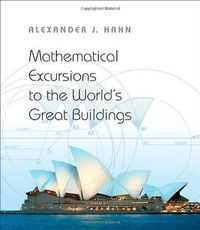
Mathematical Excursions to the World's Great Buildings
A Geometry, Science, Unfinished book. This book uses math to approach architecture 2-ways: 1) Calculating the forces acting upon a structure and...
From the pyramids and the Parthenon to the Sydney Opera House and the Bilbao Guggenheim, this book takes readers on an eye-opening tour of the mathematics behind some of the world's most spectacular buildings. Beautifully illustrated, the book explores the milestones in elementary mathematics that enliven the understanding of these buildings and combines this with an in-depth look at their aesthetics, history, and structure. Whether using trigonometry and vectors to explain why Gothic arches are structurally superior to Roman arches, or showing how simple ruler and compass constructions can produce sophisticated architectural details, Alexander Hahn describes the points at which elementary mathematics and architecture intersect.Beginning in prehistoric times, Hahn proceeds to guide readers through the Greek, Roman, Islamic, Romanesque, Gothic, Renaissance, and modern styles. He explores the unique features of the Pantheon, the Hagia Sophia, the Great Mosque of Cordoba, the Duomo in Florence, Palladio's villas, and Saint Peter's Basilica, as well as the U.S. Capitol Building. Hahn celebrates the forms and structures of architecture made possible by mathematical achievements from Greek geometry, the Hindu-Arabic number system, two- and three-dimensional coordinate geometry, and calculus. Along the way, Hahn introduces groundbreaking architects, including Brunelleschi,...
Download or read Mathematical Excursions to the World's Great Buildings in PDF formats. You may also find other subjects related with Mathematical Excursions to the World's Great Buildings.
- Filetype: PDF
- Pages: 317 pages
- ISBN: 9780691145204 / 0
S15UYBB_hUW.pdf
More About Mathematical Excursions to the World's Great Buildings
Of all the great works of art, the magnificent buildings are the ones that take the most air out of your lungs. By combining applied mathematics, engineering and serious physical effort a functional structure that is also a work of art was produced. Some of the older buildings took decades to construct and most are still as functional... This is apparently a textbook (it includes problems and discussions and defines and gives etymologies for reasonably common terms), and apparently of mathematics, but Hahn tries to cover a history of building methods and architecture in the Western World (pyramids to Gehry's Bilbao museum,) the changing relations between faith and reason... This book uses math to approach architecture 2-ways: 1) Calculating the forces acting upon a structure and 2) how math was used to generate form. I think the math to calculate reactions is better covered elsewhere and I was underwhelmed by the rest of the math content. However, that said, as a bibliophile, I know this book does have...











